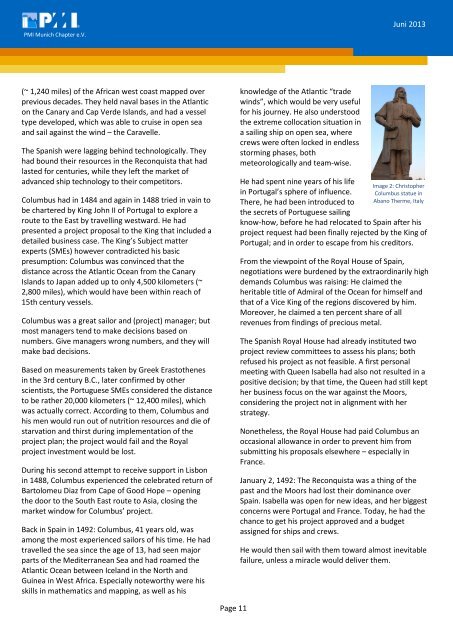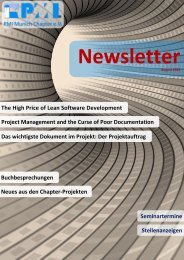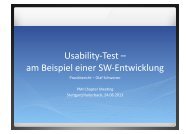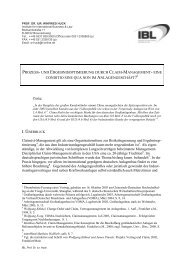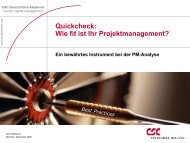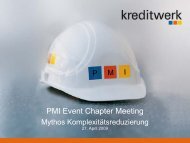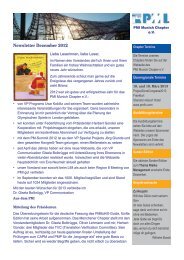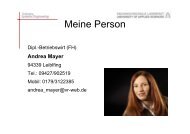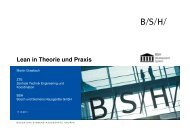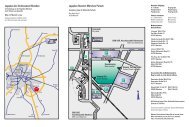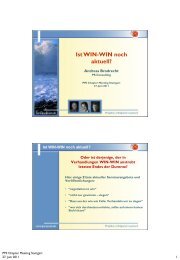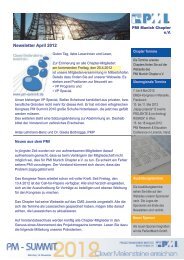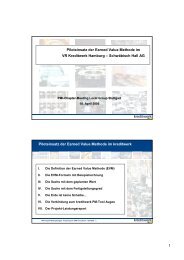Juni 2013 - PMI Munich Chapter eV
Juni 2013 - PMI Munich Chapter eV
Juni 2013 - PMI Munich Chapter eV
Erfolgreiche ePaper selbst erstellen
Machen Sie aus Ihren PDF Publikationen ein blätterbares Flipbook mit unserer einzigartigen Google optimierten e-Paper Software.
<strong>PMI</strong> <strong>Munich</strong> <strong>Chapter</strong> e.V.<br />
<strong>Juni</strong> <strong>2013</strong><br />
(~ 1,240 miles) of the African west coast mapped over<br />
previous decades. They held naval bases in the Atlantic<br />
on the Canary and Cap Verde Islands, and had a vessel<br />
type developed, which was able to cruise in open sea<br />
and sail against the wind – the Caravelle.<br />
The Spanish were lagging behind technologically. They<br />
had bound their resources in the Reconquista that had<br />
lasted for centuries, while they left the market of<br />
advanced ship technology to their competitors.<br />
Columbus had in 1484 and again in 1488 tried in vain to<br />
be chartered by King John II of Portugal to explore a<br />
route to the East by travelling westward. He had<br />
presented a project proposal to the King that included a<br />
detailed business case. The King’s Subject matter<br />
experts (SMEs) however contradicted his basic<br />
presumption: Columbus was convinced that the<br />
distance across the Atlantic Ocean from the Canary<br />
Islands to Japan added up to only 4,500 kilometers (~<br />
2,800 miles), which would have been within reach of<br />
15th century vessels.<br />
Columbus was a great sailor and (project) manager; but<br />
most managers tend to make decisions based on<br />
numbers. Give managers wrong numbers, and they will<br />
make bad decisions.<br />
Based on measurements taken by Greek Erastothenes<br />
in the 3rd century B.C., later confirmed by other<br />
scientists, the Portuguese SMEs considered the distance<br />
to be rather 20,000 kilometers (~ 12,400 miles), which<br />
was actually correct. According to them, Columbus and<br />
his men would run out of nutrition resources and die of<br />
starvation and thirst during implementation of the<br />
project plan; the project would fail and the Royal<br />
project investment would be lost.<br />
During his second attempt to receive support in Lisbon<br />
in 1488, Columbus experienced the celebrated return of<br />
Bartolomeu Diaz from Cape of Good Hope – opening<br />
the door to the South East route to Asia, closing the<br />
market window for Columbus’ project.<br />
Back in Spain in 1492: Columbus, 41 years old, was<br />
among the most experienced sailors of his time. He had<br />
travelled the sea since the age of 13, had seen major<br />
parts of the Mediterranean Sea and had roamed the<br />
Atlantic Ocean between Iceland in the North and<br />
Guinea in West Africa. Especially noteworthy were his<br />
skills in mathematics and mapping, as well as his<br />
knowledge of the Atlantic “trade<br />
winds”, which would be very useful<br />
for his journey. He also understood<br />
the extreme collocation situation in<br />
a sailing ship on open sea, where<br />
crews were often locked in endless<br />
storming phases, both<br />
meteorologically and team-wise.<br />
He had spent nine years of his life<br />
in Portugal’s sphere of influence.<br />
There, he had been introduced to<br />
the secrets of Portuguese sailing<br />
Image 2: Christopher<br />
Columbus statue in<br />
Abano Therme, Italy<br />
know-how, before he had relocated to Spain after his<br />
project request had been finally rejected by the King of<br />
Portugal; and in order to escape from his creditors.<br />
From the viewpoint of the Royal House of Spain,<br />
negotiations were burdened by the extraordinarily high<br />
demands Columbus was raising: He claimed the<br />
heritable title of Admiral of the Ocean for himself and<br />
that of a Vice King of the regions discovered by him.<br />
Moreover, he claimed a ten percent share of all<br />
revenues from findings of precious metal.<br />
The Spanish Royal House had already instituted two<br />
project review committees to assess his plans; both<br />
refused his project as not feasible. A first personal<br />
meeting with Queen Isabella had also not resulted in a<br />
positive decision; by that time, the Queen had still kept<br />
her business focus on the war against the Moors,<br />
considering the project not in alignment with her<br />
strategy.<br />
Nonetheless, the Royal House had paid Columbus an<br />
occasional allowance in order to prevent him from<br />
submitting his proposals elsewhere – especially in<br />
France.<br />
January 2, 1492: The Reconquista was a thing of the<br />
past and the Moors had lost their dominance over<br />
Spain. Isabella was open for new ideas, and her biggest<br />
concerns were Portugal and France. Today, he had the<br />
chance to get his project approved and a budget<br />
assigned for ships and crews.<br />
He would then sail with them toward almost inevitable<br />
failure, unless a miracle would deliver them.<br />
Page 11


